check engine light MITSUBISHI ECLIPSE CROSS 2018 Owner's Manual (in English)
[x] Cancel search | Manufacturer: MITSUBISHI, Model Year: 2018, Model line: ECLIPSE CROSS, Model: MITSUBISHI ECLIPSE CROSS 2018Pages: 417, PDF Size: 74.06 MB
Page 12 of 417
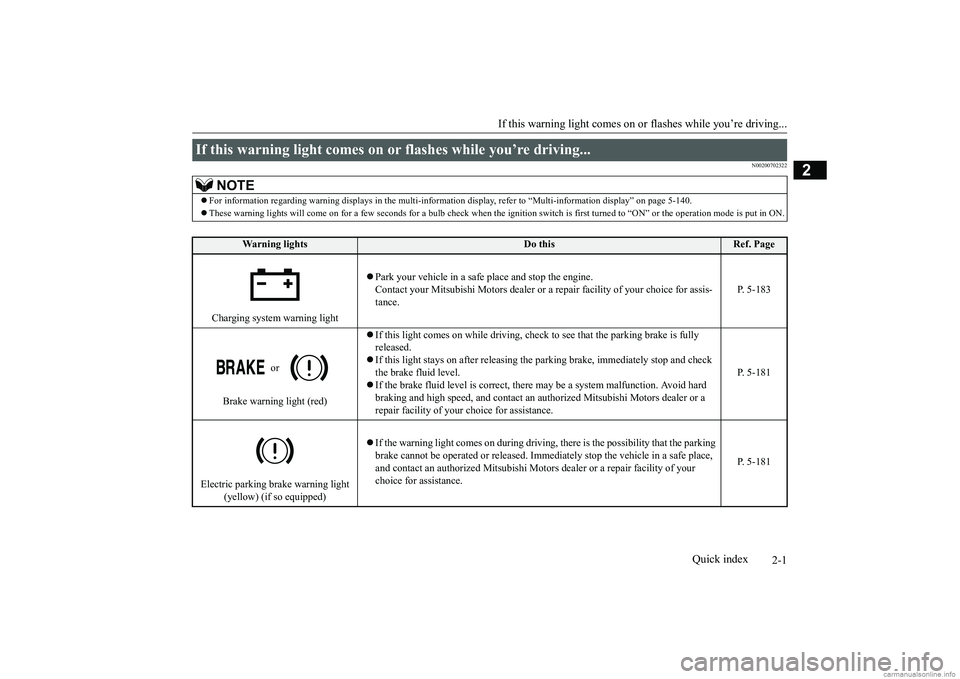
2-1
2
If this warning light comes on or
flashes while you’re driving...
Quick index
N00200702322
If this warning light comes on or flashes while you’re driving...
NOTE
For information regarding warning displays in the multi-informat
ion display, refer to “Multi-information display” on page 5-140
.
These warning lights will come on for a few seconds for a bulb check
when the ignition switch is first turned to “ON” or the op
eration mode is put in ON.
Wa r n i n g l i g h t s
Do this
Ref. Page
Charging system warning light
Park your vehicle in a safe place and stop the engine. Contact your Mitsubishi Motors dealer or
a repair facility of your choice for assis-
tance.
P. 5-183
or
Brake warning light (red)
If this light comes on while driving, check to see that the parking brake is fully released. If this light stays on after releasing the parking brake, immediately stop and check the brake fluid level. If the brake fluid level is correct, there may be a system malfunction. Avoid hard braking and high speed, and contact an aut
horized Mitsubishi Mo
tors dealer or a
repair facility of your choice for assistance.
P. 5-181
Electric parking brake warning light
(yellow) (if so equipped)
If the warning light comes on during driving, th
ere is the possibility that the parking
brake cannot be operated or released. Immediately stop the vehicle in a safe place, and contact an authorized Mitsubishi Moto
rs dealer or a repair facility of your
choice for assistance.
P. 5-181
BK0252700US.bo
ok 1 ページ 2017年10月4日 水曜日 午後4時54分
Page 13 of 417
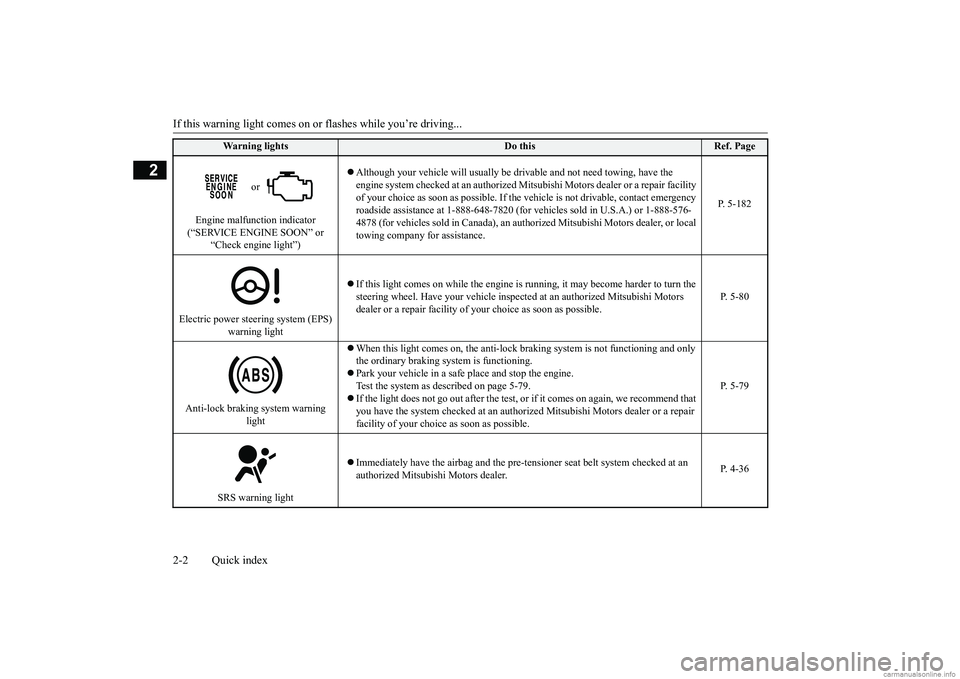
If this warning light comes on or
flashes while you’re driving...
2-2 Quick index
2
or
Engine malfunction indicator (“SERVICE ENGINE SOON” or
“Check engine light”)
Although your vehicle will usually be drivable and not need towing, have the engine system checked at an authorized Mits
ubishi Motors dealer or a repair facility
of your choice as soon as po
ssible. If the vehicle is not
drivable, contact emergency
roadside assistance at 1-888-648-7820 (for ve
hicles sold in U.S.A.) or 1-888-576-
4878 (for vehicles sold in Canada), an author
ized Mitsubishi Motors dealer, or local
towing company for assistance.
P. 5-182
Electric power steering system (EPS)
warning light
If this light comes on while the engine is
running, it may become harder to turn the
steering wheel. Have your vehicle inspected at an authorized Mitsubishi Motors dealer or a repair facility of your choice as soon as possible.
P. 5-80
Anti-lock braking system warning
light
When this light comes on, the anti-lock braking system is not functioning and only the ordinary braking system is functioning. Park your vehicle in a safe place and stop the engine. Test the system as described on page 5-79. If the light does not go out after the test, or if it comes on again, we recommend that you have the system checked at an authorized Mitsubishi Motors dealer or a repair facility of your choice as soon as possible.
P. 5-79
SRS warning light
Immediately have the airbag and the pre-te
nsioner seat belt system checked at an
authorized Mitsubishi Motors dealer.
P. 4-36
Warning lights
Do this
Ref. Page
BK0252700US.bo
ok 2 ページ 2017年10月4日 水曜日 午後4時54分
Page 14 of 417
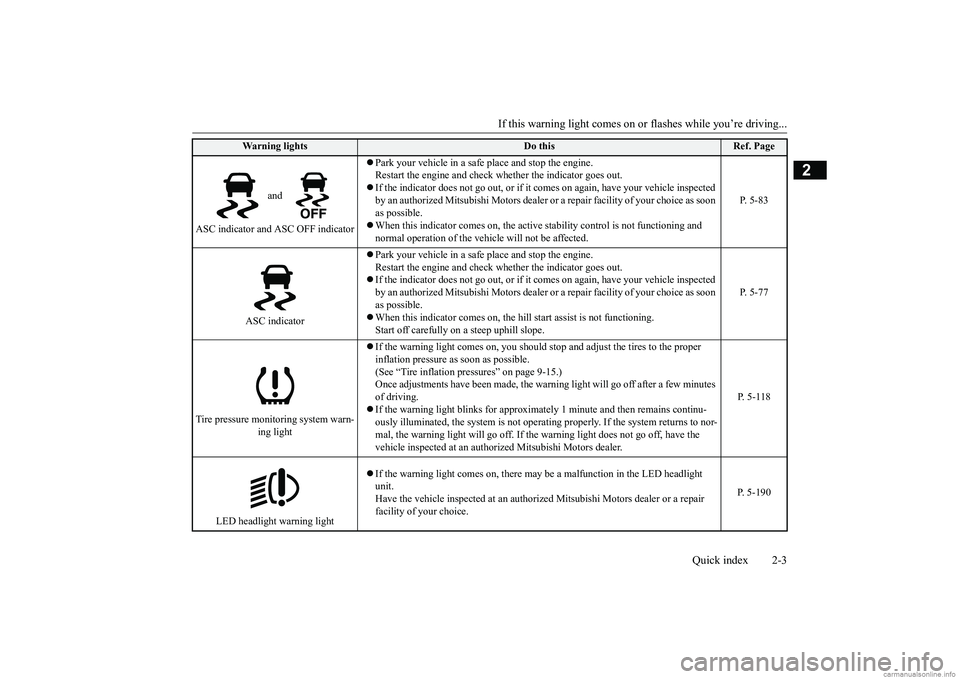
If this warning light comes on or
flashes while you’re driving...
Quick index 2-3
2
and
ASC indicator and ASC OFF indicator
Park your vehicle in a safe place and stop the engine. Restart the engine and check whether the indicator goes out. If the indicator does not go out, or if it
comes on again, have your vehicle inspected
by an authorized Mitsubishi Motors dealer or
a repair facility of your choice as soon
as possible. When this indicator comes on, the active
stability control is not functioning and
normal operation of the vehicle will not be affected.
P. 5-83
ASC indicator
Park your vehicle in a safe place and stop the engine. Restart the engine and check whether the indicator goes out. If the indicator does not go out, or if it
comes on again, have your vehicle inspected
by an authorized Mitsubishi Motors dealer or
a repair facility of your choice as soon
as possible. When this indicator comes on, the hi
ll start assist is not functioning.
Start off carefully on a steep uphill slope.
P. 5-77
Tire pressure monitoring system warn-
ing light
If the warning light comes on, you should stop and adjust the tires to the proper inflation pressure as soon as possible. (See “Tire inflation pressures” on page 9-15.)Once adjustments have been made, the warning light will go off after a few minutes of driving. If the warning light blinks for approxim
ately 1 minute and then remains continu-
ously illuminated, the system is not operatin
g properly. If the system returns to nor-
mal, the warning light will go off. If
the warning light does not go off, have the
vehicle inspected at an authori
zed Mitsubishi Motors dealer.
P. 5-118
LED headlight warning light
If the warning light comes on, there may be
a malfunction in the LED headlight
unit. Have the vehicle inspected at an authorized
Mitsubishi Motors dealer or a repair
facility of your choice.
P. 5-190
Wa r n i n g l i g h t s
Do this
Ref. Page
BK0252700US.bo
ok 3 ページ 2017年10月4日 水曜日 午後4時54分
Page 16 of 417
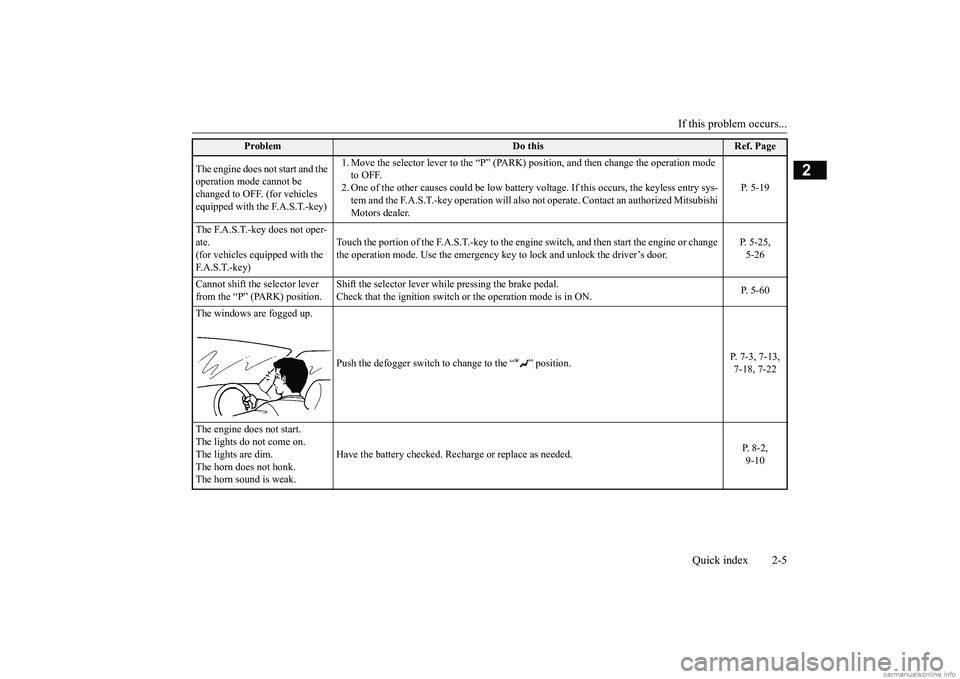
If this problem occurs...
Quick index 2-5
2
The engine does not start and the operation mode cannot be changed to OFF. (for vehicles equipped with the F.A.S.T.-key)
1. Move the selector lever to the “P” (PARK)
position, and then change the operation mode
to OFF. 2. One of the other causes could be low battery
voltage. If this occurs, the keyless entry sys-
tem and the F.A.S.T.-key operation will also no
t operate. Contact an authorized Mitsubishi
Motors dealer.
P. 5-19
The F.A.S.T.-key does not oper- ate.(for vehicles equipped with the F. A . S . T. - k e y )
Touch the portion of the F.A.S.T.-key to the engine
switch, and then start the engine or change
the operation mode. Use the emergency key to lock and unlock the driver’s door.
P. 5-25, 5-26
Cannot shift the selector lever from the “P” (PARK) position.
Shift the selector lever while pressing the brake pedal. Check that the ignition switch or the operation mode is in ON.
P. 5-60
The windows are fogged up.
Push the defogger switch to
change to the “ ” position.
P. 7-3, 7-13, 7-18, 7-22
The engine does not start. The lights do not come on. The lights are dim.The horn does not honk. The horn sound is weak.
Have the battery checked. Recharge or replace as needed.
P. 8-2, 9-10
Problem
Do this
Ref. Page
BK0252700US.bo
ok 5 ページ 2017年10月4日 水曜日 午後4時54分
Page 18 of 417
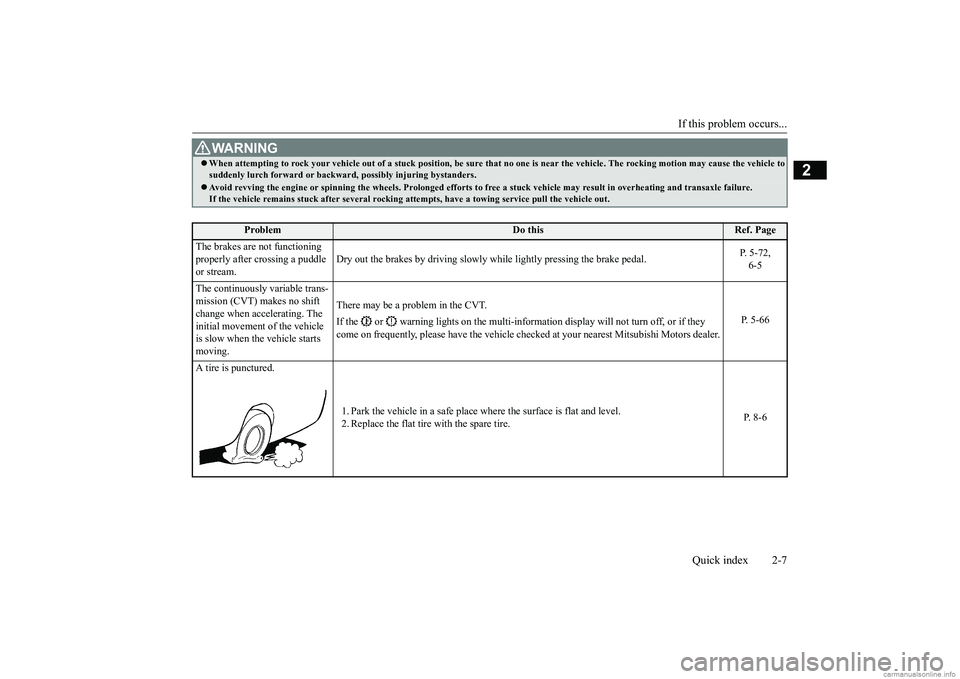
If this problem occurs...
Quick index 2-7
2
WA R N I N G When attempting to rock your vehicle out of
a stuck position, be sure that no one is
near the vehicle. The rocking motion may c
ause the vehicle to
suddenly lurch forward or backward, possibly injuring bystanders. Avoid revving the engine or spinning the
wheels. Prolonged efforts to free a stuck ve
hicle may result in overheating and transa
xle failure.
If the vehicle remains stuck after several rocking at
tempts, have a towing service pull the vehicle out.
Problem
Do this
Ref. Page
The brakes are not functioning properly after crossing a puddle or stream.
Dry out the brakes by driving slowly while lightly pressing the brake pedal.
P. 5-72, 6-5
The continuously variable trans- mission (CVT) makes no shift change when accelerating. The initial movement of the vehicle is slow when the vehicle starts moving.
There may be a problem in the CVT. If the or warning lights on the multi-information display will not turn off, or if they come on frequently, please have the vehicle check
ed at your nearest Mitsubishi Motors dealer.
P. 5-66
A tire is punctured.
1. Park the vehicle in a safe place where the surface is flat and level. 2. Replace the flat tire with the spare tire.
P. 8-6
BK0252700US.bo
ok 7 ページ 2017年10月4日 水曜日 午後4時54分
Page 22 of 417
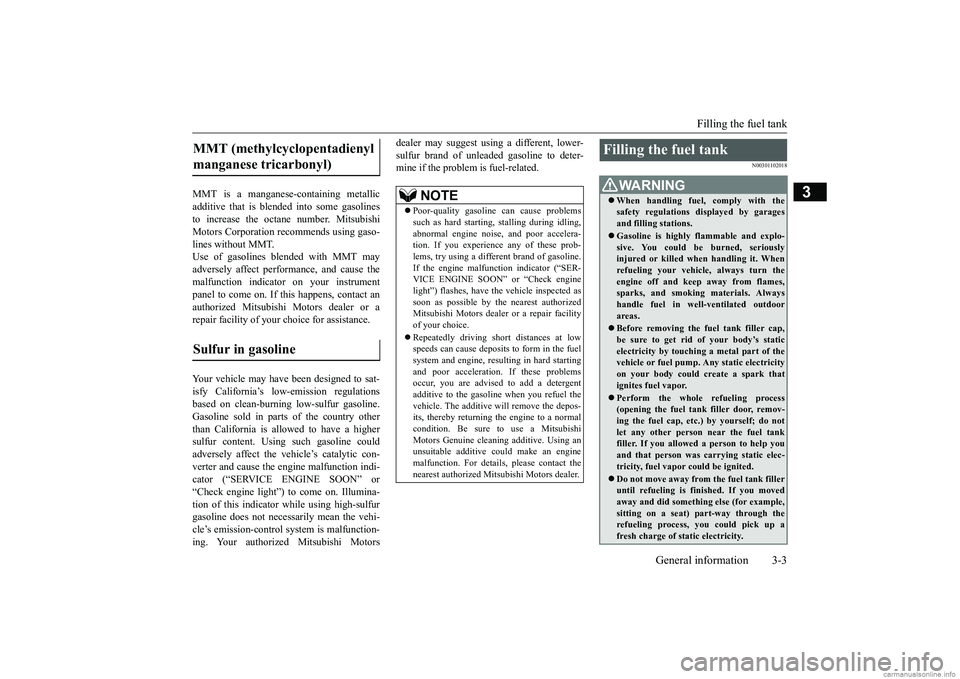
Filling the fuel tank
General information 3-3
3
MMT is a manganese-containing metallic additive that is blended into some gasolines to increase the octane number. Mitsubishi Motors Corporation recommends using gaso-lines without MMT. Use of gasolines blended with MMT may adversely affect performance, and cause themalfunction indicator on your instrumentpanel to come on. If this happens, contact an authorized Mitsubishi Motors dealer or a repair facility of your choice for assistance. Your vehicle may have been designed to sat- isfy California’s low-emission regulationsbased on clean-burning low-sulfur gasoline. Gasoline sold in parts of the country other than California is allowed to have a highersulfur content. Using such gasoline could adversely affect the vehicle’s catalytic con- verter and cause the engine malfunction indi-cator (“SERVICE ENGINE SOON” or “Check engine light”) to come on. Illumina- tion of this indicator while using high-sulfurgasoline does not necessarily mean the vehi- cle’s emission-control system is malfunction- ing. Your authorized Mitsubishi Motors
dealer may suggest using a different, lower- sulfur brand of unleaded gasoline to deter- mine if the problem is fuel-related.
N00301102018
MMT (methylcyclopentadienyl manganese tricarbonyl) Sulfur in gasoline
NOTE
Poor-quality gasoline can cause problems such as hard starting, stalling during idling, abnormal engine noise, and poor accelera- tion. If you experience any of these prob-lems, try using a different brand of gasoline. If the engine malfunction indicator (“SER- VICE ENGINE SOON” or “Check enginelight”) flashes, have the vehicle inspected as soon as possible by the nearest authorized Mitsubishi Motors dealer or a repair facilityof your choice. Repeatedly driving short distances at low speeds can cause deposits to form in the fuel system and engine, resulting in hard starting and poor acceleration. If these problemsoccur, you are advised to add a detergent additive to the gasoline when you refuel the vehicle. The additive will remove the depos-its, thereby returning the engine to a normal condition. Be sure to use a Mitsubishi Motors Genuine cleaning additive. Using anunsuitable additive could make an engine malfunction. For details, please contact the nearest authorized Mitsubishi Motors dealer.
Filling the fuel tank
WA R N I N G When handling fuel, comply with the safety regulations displayed by garages and filling stations. Gasoline is highly flammable and explo- sive. You could be burned, seriously injured or killed when handling it. Whenrefueling your vehicle, always turn the engine off and keep away from flames, sparks, and smoking materials. Alwayshandle fuel in well-ventilated outdoor areas. Before removing the fuel tank filler cap, be sure to get rid of your body’s static electricity by touching a metal part of thevehicle or fuel pump. Any static electricity on your body could create a spark that ignites fuel vapor. Perform the whole refueling process (opening the fuel tank filler door, remov-ing the fuel cap, etc.) by yourself; do not let any other person near the fuel tank filler. If you allowed a person to help youand that person was carrying static elec- tricity, fuel vapor could be ignited. Do not move away from the fuel tank filler until refueling is finished. If you movedaway and did something else (for example, sitting on a seat) part-way through the refueling process, you could pick up afresh charge of static electricity.
BK0252700US.bo
ok 3 ページ 2017年10月4日 水曜日 午後4時54分
Page 24 of 417
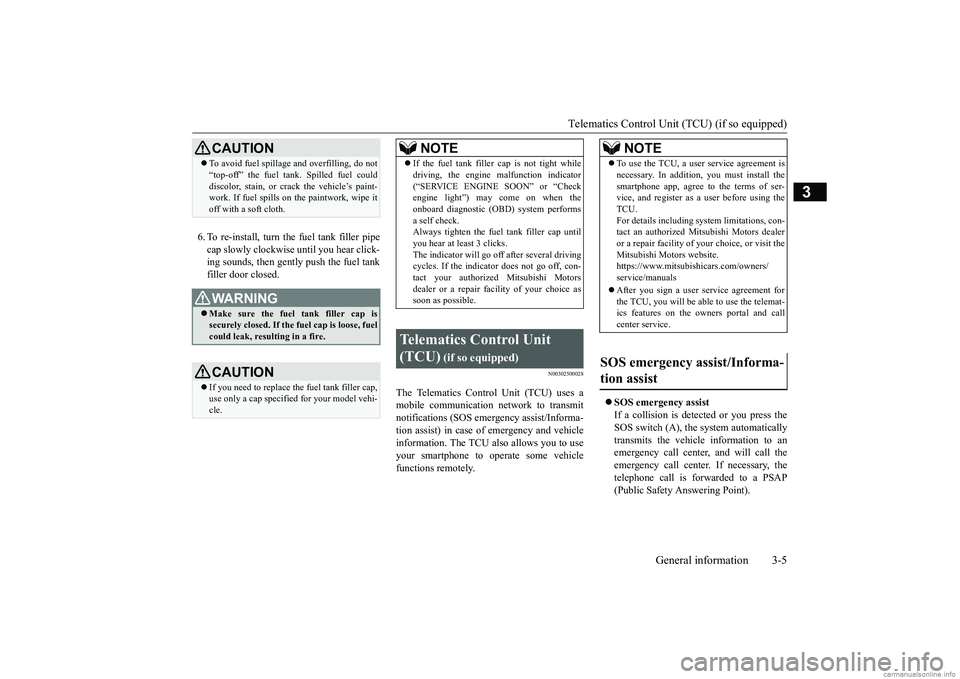
Telematics Control Unit (TCU) (if so equipped)
General information 3-5
3
6. To re-install, turn the fuel tank filler pipe cap slowly clockwise until you hear click- ing sounds, then gently push the fuel tank filler door closed.
N00302500028
The Telematics Control Unit (TCU) uses amobile communication network to transmitnotifications (SOS emergency assist/Informa- tion assist) in case of emergency and vehicle information. The TCU also allows you to useyour smartphone to operate some vehicle functions remotely.
SOS emergency assist If a collision is detected or you press the SOS switch (A), the system automaticallytransmits the vehicle information to an emergency call center, and will call the emergency call center. If necessary, thetelephone call is forwarded to a PSAP (Public Safety Answering Point).
CAUTION To avoid fuel spillage and overfilling, do not “top-off” the fuel tank. Spilled fuel could discolor, stain, or crack the vehicle’s paint- work. If fuel spills on the paintwork, wipe it off with a soft cloth.WA R N I N G Make sure the fuel tank filler cap is securely closed. If the fuel cap is loose, fuel could leak, resulting in a fire.CAUTION If you need to replace the fuel tank filler cap, use only a cap specified for your model vehi- cle.
NOTE
If the fuel tank filler
cap is not tight while
driving, the engine malfunction indicator (“SERVICE ENGINE SOON” or “Check engine light”) may come on when the onboard diagnostic (OBD) system performsa self check. Always tighten the fuel tank filler cap until you hear at least 3 clicks.The indicator will go off after several driving cycles. If the indicator does not go off, con- tact your authorized Mitsubishi Motorsdealer or a repair facility of your choice as soon as possible.
Telematics Control Unit (TCU)
(if so equipped)
NOTE
To use the TCU, a user service agreement is necessary. In addition, you must install the smartphone app, agree to the terms of ser- vice, and register as a user before using the TCU.For details including system limitations, con- tact an authorized Mitsubishi Motors dealer or a repair facility of
your choice, or visit the
Mitsubishi Motors website. https://www.mitsubishicars.com/owners/ service/manuals After you sign a user service agreement for the TCU, you will be able to use the telemat-ics features on the owners portal and call center service.
SOS emergency assist/Informa- tion assist
BK0252700US.bo
ok 5 ページ 2017年10月4日 水曜日 午後4時54分
Page 105 of 417
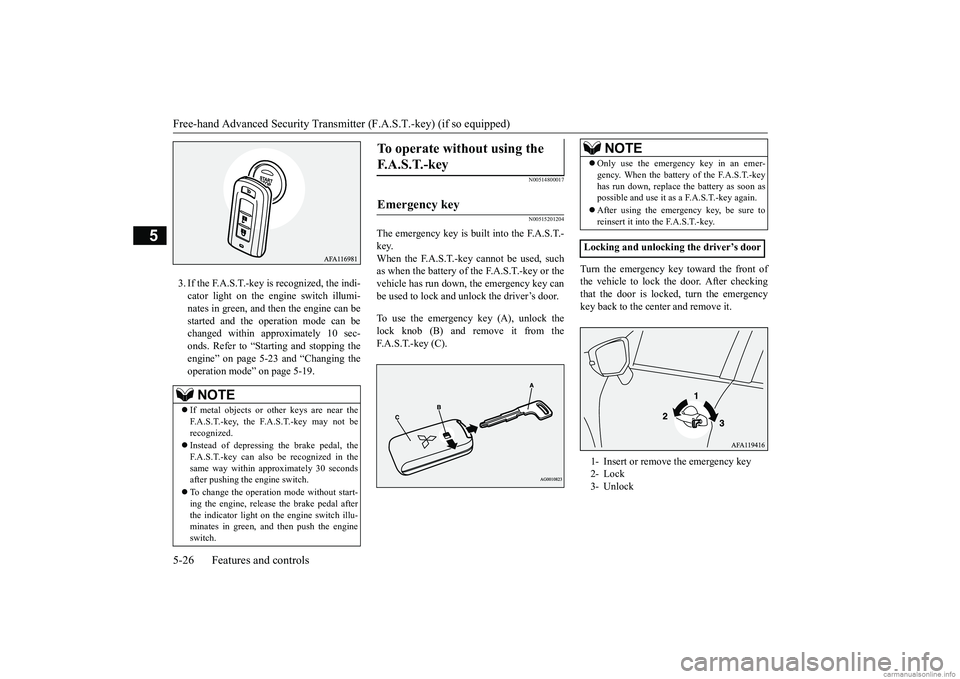
Free-hand Advanced Security Transmitter (F.A.S.T.-key) (if so equipped) 5-26 Features and controls
5
3. If the F.A.S.T.-key is recognized, the indi- cator light on the engine switch illumi-nates in green, and then the engine can be started and the operation mode can be changed within approximately 10 sec-onds. Refer to “Starting and stopping the engine” on page 5-23 and “Changing the operation mode” on page 5-19.
N00514800017 N00515201204
The emergency key is built into the F.A.S.T.- key. When the F.A.S.T.-key cannot be used, such as when the battery of the F.A.S.T.-key or thevehicle has run down, the emergency key canbe used to lock and unlock the driver’s door. To use the emergency key (A), unlock the lock knob (B) and remove it from the F.A.S.T.-key (C).
Turn the emergency key toward the front of the vehicle to lock the door. After checking that the door is locked, turn the emergencykey back to the center and remove it.
NOTE
If metal objects or other keys are near the F.A.S.T.-key, the F.A.S.T.-key may not be recognized. Instead of depressing the brake pedal, the F.A.S.T.-key can also be recognized in the same way within approximately 30 secondsafter pushing the engine switch. To change the operation mode without start- ing the engine, release the brake pedal after the indicator light on the engine switch illu- minates in green, and then push the engineswitch.
To operate without using the F. A . S . T. - k e y
Emergency key
NOTE
Only use the emergency key in an emer- gency. When the battery of the F.A.S.T.-key has run down, replace the battery as soon as possible and use it as a F.A.S.T.-key again. After using the emergency key, be sure to reinsert it into the F.A.S.T.-key.
Locking and unlocking the driver’s door 1- Insert or remove the emergency key 2- Lock 3- Unlock
BK0252700US.bo
ok 26 ページ 2017年10月4日 水曜日 午後4時54分
Page 151 of 417
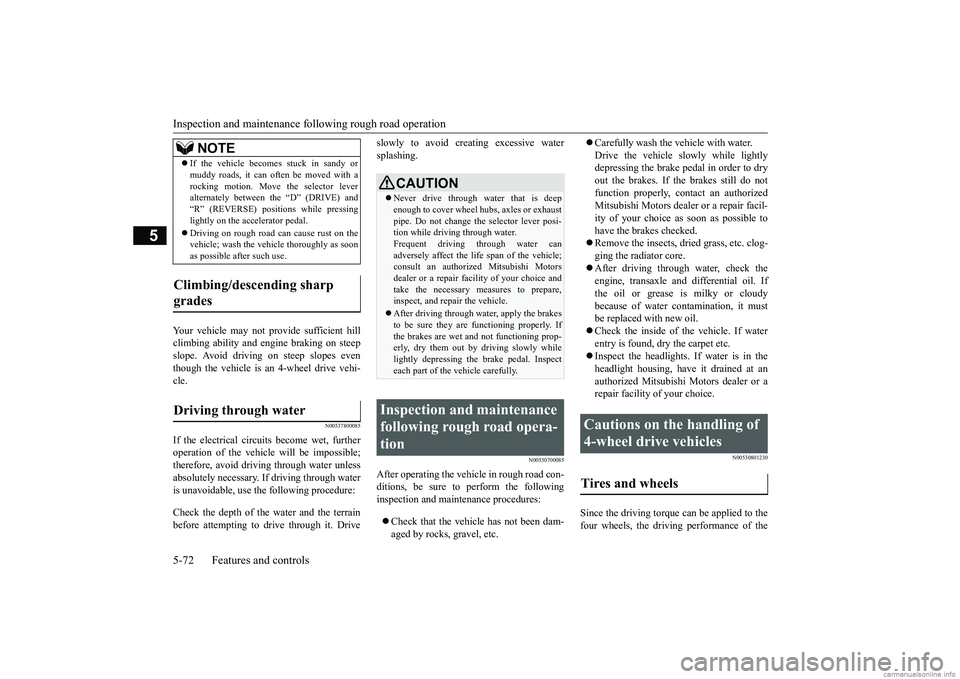
Inspection and maintenance foll
owing rough road operation
5-72 Features and controls
5
Your vehicle may not provide sufficient hill climbing ability and engine braking on steep slope. Avoid driving on steep slopes eventhough the vehicle is an 4-wheel drive vehi- cle.
N00537800085
If the electrical circuits become wet, furtheroperation of the vehicle will be impossible; therefore, avoid driving through water unlessabsolutely necessary. If driving through water is unavoidable, use the following procedure: Check the depth of the water and the terrain before attempting to drive through it. Drive
slowly to avoid creating excessive water splashing.
N00530700085
After operating the vehicle in rough road con- ditions, be sure to perform the following inspection and maintenance procedures: Check that the vehicle has not been dam- aged by rocks, gravel, etc.
Carefully wash the vehicle with water. Drive the vehicle slowly while lightly depressing the brake pedal in order to dry out the brakes. If the brakes still do notfunction properly, contact an authorized Mitsubishi Motors dealer or a repair facil- ity of your choice as soon as possible tohave the brakes checked. Remove the insects, dried grass, etc. clog- ging the radiator core. After driving through water, check the engine, transaxle and differential oil. If the oil or grease is milky or cloudy because of water contamination, it mustbe replaced with new oil. Check the inside of the vehicle. If water entry is found, dry the carpet etc. Inspect the headlights. If water is in the headlight housing, have it drained at an authorized Mitsubishi Motors dealer or arepair facility of your choice.
N00530801230
Since the driving torque can be applied to thefour wheels, the driving performance of the
If the vehicle becomes stuck in sandy or muddy roads, it can often be moved with a rocking motion. Move the selector lever alternately between the “D” (DRIVE) and “R” (REVERSE) positions while pressinglightly on the accelerator pedal. Driving on rough road can cause rust on the vehicle; wash the vehicle thoroughly as soon as possible after such use.
Climbing/descending sharp grades Driving through water
NOTE
CAUTION Never drive through water that is deep enough to cover wheel hubs, axles or exhaust pipe. Do not change the selector lever posi-tion while driving through water. Frequent driving through water can adversely affect the life span of the vehicle;consult an authorized Mitsubishi Motors dealer or a repair facility of your choice and take the necessary measures to prepare,inspect, and repair the vehicle. After driving through water, apply the brakes to be sure they are functioning properly. If the brakes are wet and not functioning prop- erly, dry them out by driving slowly whilelightly depressing the brake pedal. Inspect each part of the vehicle carefully.
Inspection and maintenance following rough road opera-tion
Cautions on the handling of 4-wheel drive vehicles Tires and wheels
BK0252700US.bo
ok 72 ページ 2017年10月4日 水曜日 午後4時54分
Page 157 of 417
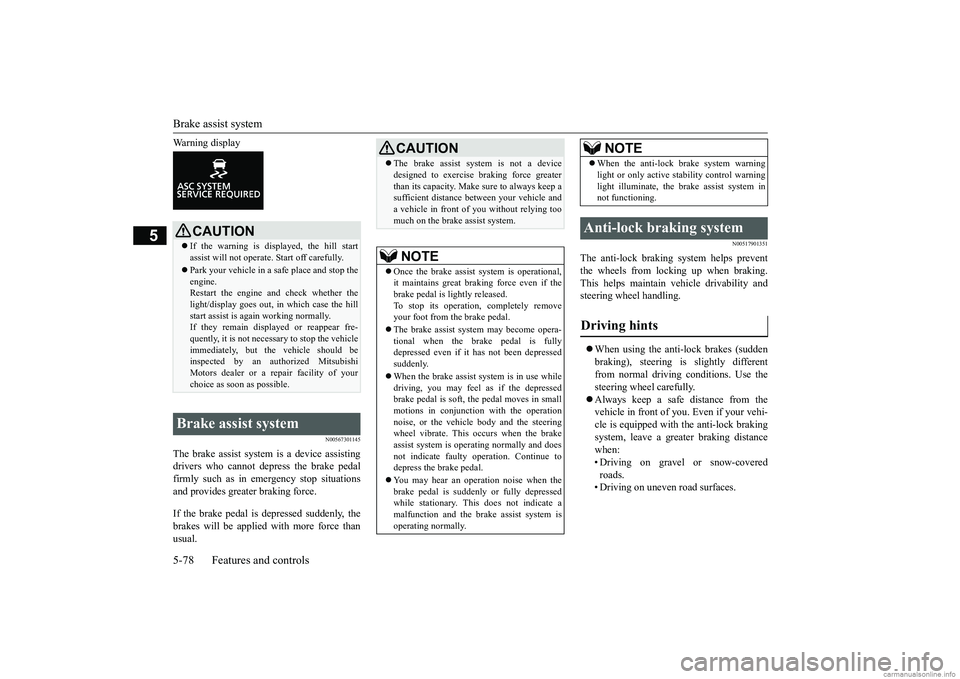
Brake assist system 5-78 Features and controls
5
Warning display
N00567301145
The brake assist system is a device assisting drivers who cannot depress the brake pedal firmly such as in emergency stop situationsand provides greater braking force. If the brake pedal is depressed suddenly, the brakes will be applied with more force than usual.
N00517901351
The anti-lock braking system helps preventthe wheels from locking up when braking. This helps maintain vehicle drivability and steering wheel handling. When using the anti-lock brakes (sudden braking), steering is slightly different from normal driving conditions. Use thesteering wheel carefully. Always keep a safe distance from the vehicle in front of you. Even if your vehi-cle is equipped with the anti-lock braking system, leave a greater braking distance when:• Driving on gravel or snow-covered roads. • Driving on uneven road surfaces.
CAUTION If the warning is displayed, the hill start assist will not operate. Start off carefully. Park your vehicle in a safe place and stop the engine. Restart the engine and check whether thelight/display goes out, in which case the hill start assist is again working normally. If they remain displayed or reappear fre-quently, it is not necessary to stop the vehicle immediately, but the vehicle should be inspected by an authorized MitsubishiMotors dealer or a repair facility of your choice as soon as possible.
Brake assist system
CAUTION The brake assist system is not a device designed to exercise braking force greater than its capacity. Make sure to always keep a sufficient distance between your vehicle and a vehicle in front of you without relying toomuch on the brake assist system.NOTE
Once the brake assist system is operational, it maintains great braking force even if thebrake pedal is lightly released. To stop its operation, completely remove your foot from the brake pedal. The brake assist system may become opera- tional when the brake pedal is fullydepressed even if it has not been depressed suddenly. When the brake assist system is in use while driving, you may feel as if the depressed brake pedal is soft, the pedal moves in smallmotions in conjunction with the operation noise, or the vehicle body and the steering wheel vibrate. This occurs when the brakeassist system is operating normally and does not indicate faulty operation. Continue to depress the brake pedal. You may hear an operation noise when the brake pedal is suddenly or fully depressed while stationary. This does not indicate a malfunction and the brake assist system isoperating normally.
When the anti-lock brake system warning light or only active stability control warning light illuminate, the brake assist system in not functioning.
Anti-lock braking system Driving hints
NOTE
BK0252700US.bo
ok 78 ページ 2017年10月4日 水曜日 午後4時54分